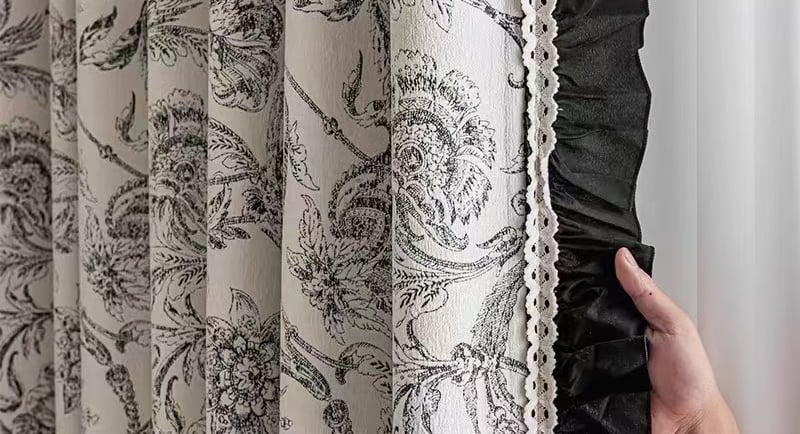Geometric vs. Floral: Choosing the Right Curtain Pattern for Your Space
11/24/20244 min read


Understanding the Basics of Curtain Patterns
Curtain patterns can significantly influence the ambiance and style of a space, making the choice between geometric and floral designs a crucial one. Geometric patterns are characterized by their use of shapes, lines, and symmetry. These patterns typically include forms such as triangles, squares, and circles arranged in repetitive or structured designs. Curtains featuring geometric motifs often create a modern and clean aesthetic, appealing to those who prefer a minimalist or contemporary decor style. The use of crisp lines and symmetrical arrangements can make a room feel more ordered and spacious, contributing to an atmosphere of sophistication.
On the other hand, floral patterns bring a contrasting dynamic to the table. These designs often feature a variety of botanical motifs, ranging from delicate blossoms to lush foliage, embodying a sense of movement and warmth. Floral curtains can evoke feelings of nostalgia and romanticism, appealing to individuals who appreciate traditional or vintage styles. The soft curves and organic shapes typical of these patterns introduce a welcoming and relaxed ambiance, often making spaces feel more inviting and comfortable.
Moreover, the choice between geometric and floral patterns can also reflect personal taste and affect how a space is perceived by others. For instance, a room with geometric curtains may convey a sense of elegance and modernity, while floral curtains may elicit a homier and more familiar atmosphere. It's important to consider not only the existing decor and color palette of the room but also the mood one wishes to create. By understanding these fundamental differences, homeowners can make informed decisions when selecting the ideal curtain patterns that enhance their spaces.
Evaluating Your Interior Design Style
When it comes to choosing the right curtain pattern for your space, understanding your existing interior design style is essential. Begin by analyzing the key decor elements within the room. Take note of the furniture style, accessories, and any prominent architectural features. By recognizing these components, you can better understand how geometric or floral patterns will complement your overall design.
Next, consider your color schemes. The colors present in your room play a pivotal role in determining which curtain pattern will be more cohesive. If your space boasts a neutral palette accented by bold colors, geometric patterns could enhance the modern aesthetic. On the other hand, if your interior decor leans towards soft pastels or earth tones, floral curtains may provide a warm, inviting touch, harmonizing with the existing hues.
Additionally, furniture style significantly influences your curtain choice. Modern and contemporary designs often pair well with geometric patterns, which can help create a clean and structured look. Alternatively, traditional furniture styles, such as Victorian or cottage, tend to work seamlessly with floral patterns, evoking a sense of classic elegance. Exploring how the shape and size of your furnishings interact with various curtain designs is critical for achieving a cohesive space.
To facilitate the selection process, consider creating mood boards that showcase potential curtain patterns alongside your current decor. This visual representation can help identify which patterns align best with your internal aesthetic. Remember, the goal is to achieve synergy between your chosen curtain style and the room's existing decor. Taking these steps to evaluate your interior design style can ultimately guide you toward making an informed decision about whether geometric or floral curtains will enhance your space effectively.
Considering Practical Aspects of Curtain Patterns
Choosing the right curtain pattern for your space requires careful consideration of various practical aspects that contribute to the overall design and functionality of a room. One of the primary factors to consider is the size of the room. For instance, bold geometric patterns, known for their strong lines and shapes, can create a striking look; however, they may also give the illusion of reduced space, especially in compact areas. Conversely, light and airy floral patterns can create a sense of expansiveness, making smaller rooms feel more inviting and larger than they actually are.
Natural light is another crucial element in selecting curtain patterns. Rooms with ample sunlight can benefit from light floral motifs that reflect brightness and energy, enhancing the warmth of the space. In contrast, rooms that receive limited natural light might be better suited to brighter geometric designs that inject vibrancy and a sense of life into darker settings. The interplay between the pattern and the light will significantly influence the overall ambiance.
Privacy is also a vital aspect to consider when choosing between geometric and floral designs. If a room requires a high level of privacy, heavier fabrics with more pronounced patterns may offer greater opacity, whereas sheer light floral curtains, while aesthetically pleasing, may not provide sufficient coverage. Additionally, the fabric's durability and maintenance should be factored into your decision. Certain fabrics, such as cotton or linen used in floral patterns, tend to be easier to clean and maintain, while some synthetic materials used in geometric designs might offer superior longevity against wear and tear.
In summary, evaluating these practical aspects—room size, natural light availability, desired privacy levels, and the maintenance of materials—will help in making an informed decision on whether geometric or floral curtain patterns are the best fit for your living space.
Making the Final Decision: Tips and Inspiration
As you approach the choice between geometric and floral curtain patterns, it is essential to contemplate several factors that can significantly influence your decision. Start by gathering fabric samples of both pattern types. This hands-on approach allows you to assess texture, color, and design scale in relation to your room's existing decor. By transporting samples into your space, you can visualize how the patterns interact with your furniture, wall colors, and overall ambiance. Taking your time to evaluate these avenues ensures that your final selection harmonizes with your interior design.
When visualizing your options, consider the layering of patterns. Mixing geometric and floral patterns can create a lively, well-balanced look, provided the patterns share a color palette or complementary tones. This technique adds depth to your space and showcases your unique style. For example, pairing bold geometric curtains with a subtle floral accent cushion can produce a refreshing and contemporary effect, while maintaining visual cohesion.
To further inspire your choices, reflect on the overall theme and function of each room. In quieter spaces, like a bedroom or home office, a gentle floral design can evoke serenity and warmth. Conversely, a more vibrant geometric pattern can inject energy into common areas such as living or dining rooms. Explore inspirations from various sources, including design blogs, magazines, and social media platforms, to discover how others have successfully incorporated these patterns into their homes.
Ultimately, the choice between geometric and floral curtain patterns is a reflection of your individual taste. Take time to explore the options, visualize your combinations, and draw from the wealth of inspiration available. This informed approach will empower you to make a decision that enhances your space and resonates with your personal style.
Curtains&Fabrics
Design,production,sales,service in curtain fabrics&curtians.
Quality
Products
sales01@anytextile.com
+8615968501933
© 2024. SHAOXING LEYAO IMPORT AND EXPORT CO.LTD All rights reserved.
